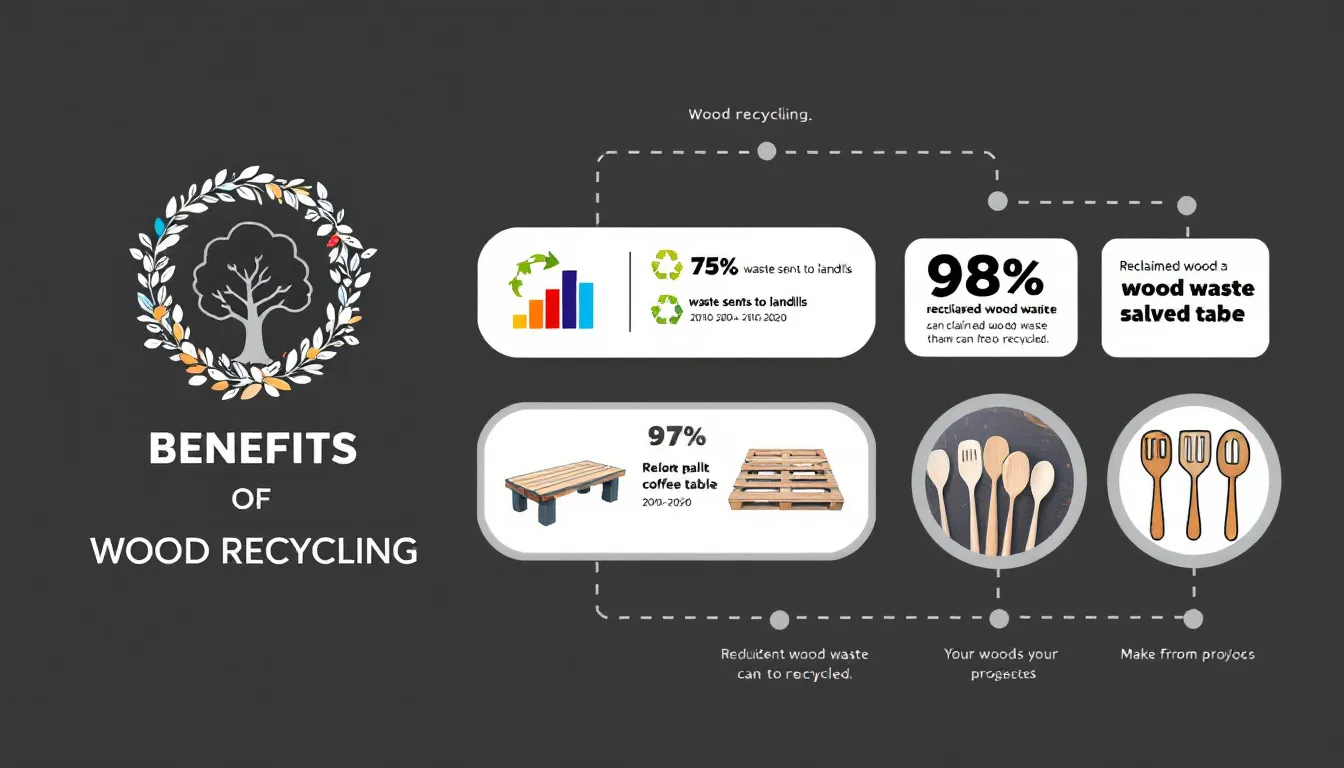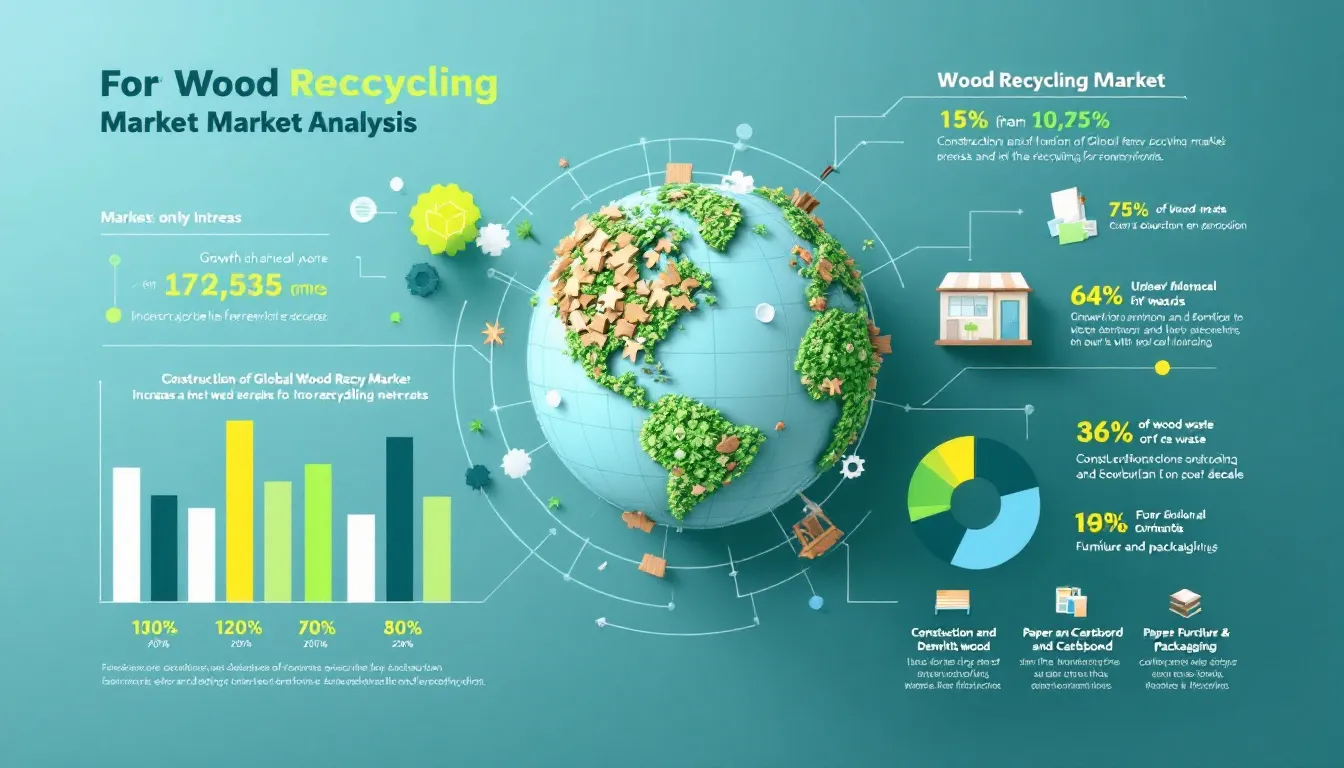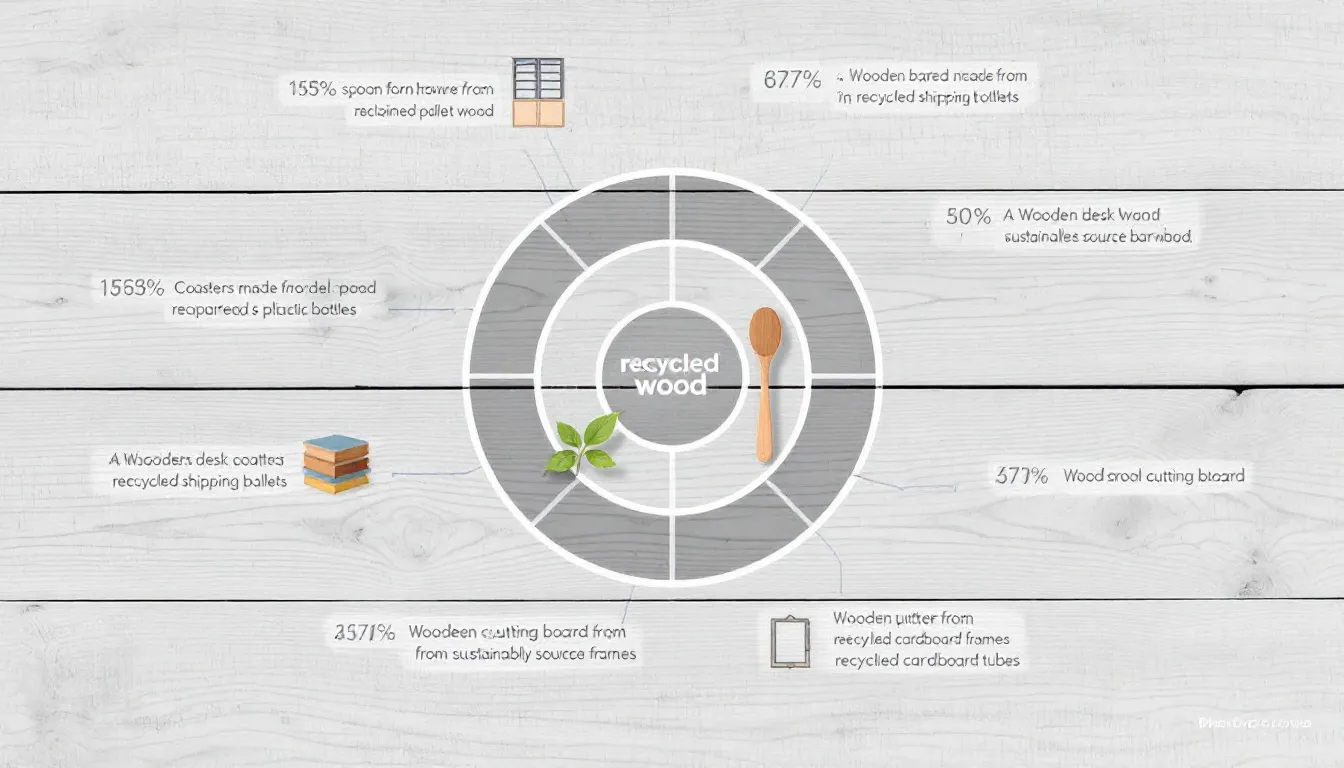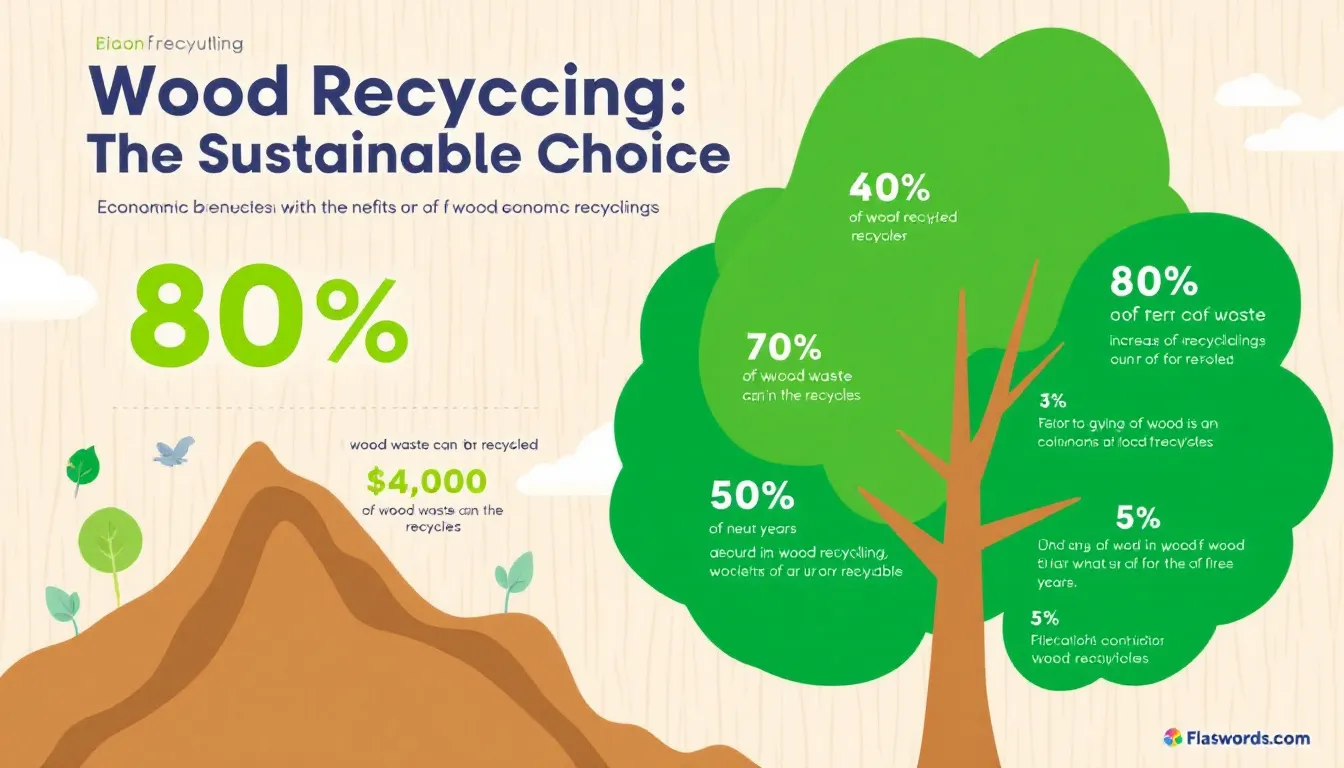Starting a wood recycling project? This wood recycling project report provides all you need to know. Learn about essential strategies, market trends, equipment, and regulatory compliance to make your project a success.

Wood recycling involves converting waste wood from various sources into valuable products, reducing the need for new wood and minimizing environmental impact. This process is essential for managing wood waste from construction and demolition debris, pallets, and old furniture. Effective recycling projects incorporate market analysis, financial projections, and operational strategies to ensure success in recycling wood waste.
Promoting wood recycling not only benefits the environment but also enhances a company’s public image, especially among environmentally conscious consumers. Recycling wood allows companies to create a variety of new products, including reclaimed wood furniture, wood pellets for fuel, and processed materials for construction.
The global wood recycling market is driven by the need for sustainable materials and the growing demand for recycled wood products in various industries.
A comprehensive wood recycling project report should outline the project’s goals, methodologies, and data analysis. The goals should detail the expected outcomes, such as the volume of wood to be recycled and the types of products to be created.
The methodology outlines the processes and techniques for collecting, sorting, and recycling wood, ensuring smooth project execution. Data analysis evaluates the success of recycling efforts against initial objectives, helping to identify areas for improvement and measure overall impact.
Additionally, engaging stakeholders and incorporating their insights can significantly enhance the project’s success, ensuring that all parties are informed and invested in the recycling initiative.

The wood recycling market is poised for significant growth, projected to reach USD 15.82 billion by 2029, with a compound annual growth rate (CAGR) of 9.1% from 2024 to 2029. This growth is driven by increasing awareness of sustainable practices, environmental conservation, and the demand for recycled products in construction and furniture industries.
North America is expected to lead the wood recycling market in 2025, driven by stringent environmental regulations and a strong emphasis on renewable materials. However, challenges such as high recycling costs and the limited availability of quality recycled wood remain.
A SWOT analysis can help identify strengths, weaknesses, opportunities, and threats, providing a strategic framework for navigating the global wood recycling market.
Wood recycling projects rely on various types of waste wood, including pallets, furniture, and construction debris. These materials are collected from sources such as construction sites, demolition projects, and industrial facilities. Effective procurement strategies are essential for ensuring a consistent supply of waste wood.
Maximizing wood recycling efficiency involves implementing robust waste wood procurement strategies. This includes partnering with construction and demolition companies and creating collection programs for industrial and residential wood waste. Securing a steady supply of raw materials ensures recycling projects can consistently produce high-quality recycled wood products.

Recycled wood can be transformed into a variety of products, ranging from biomass fuel to furniture and panel boards made from recyclable material. Biomass fuel, derived from organic materials, is a renewable energy source that helps reduce reliance on fossil fuels. Pallets can be repurposed into animal bedding and biomass fuel, while shredded wood waste can be used for landscaping and biofuels.
After: Recycled wood can be transformed into a variety of products, including:
The panel board industry heavily relies on recycled wood as a key raw material, producing items like furniture and flooring. A growing trend involves creating landscaping items and biofuels from recycled wood, contributing to a circular economy in the wood industry.
Effective wood waste management starts with sorting and classifying the wood into specific grades, which determines the appropriate recycling methods. Innovative technologies, such as artificial intelligence and smart bins, significantly enhance the sorting process, reducing contamination risks and improving efficiency.
Logistics systems play a crucial role in successful wood recycling operations. Optimized collection routes and strategic partnerships help streamline the recycling process, ensuring that wood waste is efficiently collected and transported to recycling facilities.
Recent regulatory changes have reclassified certain wood waste from the construction and demolition industry as hazardous, impacting its handling and disposal. Grade D wood waste and wood from structures built before 2007 now require specialized handling to ensure safety during recycling.
The Environmental Agency’s withdrawal of the Regulatory Position Statement (RPS) 250 has further altered how hazardous wood waste is identified and managed. Compliance with these new regulations is crucial for wood recycling projects to avoid penalties and ensure environmental safety.

Recycling wood offers significant economic benefits, primarily by reducing expenses for manufacturers. Using recycled materials is often more cost-effective than processing virgin materials, leading to substantial cost savings. Additionally, innovative approaches and efficient processing techniques can enhance the profitability of wood recycling projects.
Wood recycling also contributes to job creation within the recycling and manufacturing sectors, boosting local economies. The expected outcomes of wood recycling projects should include both environmental impacts and economic advantages, ensuring a comprehensive approach to sustainability.
Wood recycling plays a crucial role in reducing greenhouse gas emissions, which are major contributors to climate change. Converting discarded wood into usable products helps reduce deforestation and preserve natural resources.
The recycling process for wood conserves up to 40% more energy compared to using raw wood fibers, leading to substantial savings in energy costs. Recycling wood reduces the volume of waste sent to landfills, minimizing environmental pollution and landfill management costs.
Technological advancements are driving efficiency and innovation in wood recycling. Pyrolysis technology, for instance, converts wood waste into usable fuel by heating it at high temperatures in low oxygen conditions. Nanotechnology is also making strides by breaking down materials to their molecular level, enhancing their properties for reuse.
Companies like Dieffenbacher and Hurni Group have successfully incorporated advanced equipment, such as shredders and specialized screens, to improve the quality of recycled wood products. Digital technologies are increasingly adopted to enhance efficiency and track materials throughout the recycling process.
A successful wood recycling project requires specific machinery, including shredders, chippers, grinders, and conveyors. These machines are essential for breaking down and processing waste wood into usable products. The estimated cost of machinery can vary, but investing in high-quality equipment is crucial for ensuring efficient operations.
Potential suppliers and vendors should be thoroughly researched to find the best deals and reliable machinery. Partnering with reputable suppliers ensures recycling projects secure the necessary equipment to handle various types of wood waste effectively.
Choosing the right location for a wood recycling plant is critical for the project’s success. Factors such as proximity to waste wood sources, transportation networks, and local regulations should be considered during site selection. A well-planned facility setup, including adequate space for machinery and storage, is also essential.
Transportation and logistics play a significant role in the efficiency of wood recycling operations. Optimized collection routes and strategic partnerships with transportation companies ensure efficient collection and transportation of waste wood to recycling plants.
Wood recycling projects can generate revenue through various streams, including the sale of recycled wood products and supplying materials to wood processing industries. Partnerships with furniture and construction companies can also provide steady demand for recycled materials.
Export opportunities offer additional revenue potential, especially in regions with high demand for sustainable materials. Tapping into the global market allows wood recycling projects to expand their reach and profitability.
Detailed financial analysis is essential for any wood recycling project, including a breakdown of capital investments for land, machinery, and working capital. Operational costs, including labor, utilities, and maintenance, must also be considered.
Revenue projections and profitability analysis help determine the project’s financial viability. Break-even analysis provides insights into when the project will start generating profits, ensuring effective management of financial resources.
Wood recycling projects must navigate legal and regulatory requirements. Government policies and recycling laws, especially in regions like India, must be thoroughly understood and adhered to. Obtaining required licenses and permits ensures compliance with local regulations.
Environmental regulations and sustainability measures are also critical. Projects must implement practices that minimize environmental impact and promote sustainability, aligning with regulatory standards and societal expectations.
Wood recycling offers significant environmental and social benefits. By reducing deforestation and carbon footprint, recycling projects help mitigate climate change and preserve natural resources. The reduction of carbon emissions through wood recycling also contributes to a healthier environment.
Beyond environmental benefits, wood recycling projects generate employment opportunities, supporting local economies and fostering social development. These projects also improve community well-being and promote sustainable practices.

Successful wood recycling projects, such as those by EcoTimber and GreenWood, demonstrate the potential for economic and environmental benefits. These companies have utilized innovative techniques to recycle wood from construction and demolition debris into valuable products like recycled timber furniture and particle board.
WoodCycle and XYZ Wood Recycling exemplify how automation and advanced technologies can enhance the efficiency and profitability of wood recycling operations. Focusing on long-term commitment and sustainability, these projects showcase the viability and impact of wood recycling initiatives.
Wood recycling projects face several challenges, including logistical complexities and compliance with evolving environmental regulations. The presence of non-wood contaminants and variations in wood quality further complicate the recycling process. Technological limitations in sourcing appropriate machinery and handling hazardous wood waste are also significant hurdles.
Overcoming these challenges requires careful planning, investment in advanced technology, and adherence to regulatory standards.
Identifying potential challenges and developing strategies to mitigate risks are crucial for the success of wood recycling projects. Common risks include logistical issues, regulatory compliance, and material quality.
Mitigation strategies involve investing in advanced sorting and processing technologies, establishing robust procurement and logistics systems, and ensuring compliance with environmental regulations. Proactively addressing these risks enhances the efficiency and sustainability of wood recycling projects.
The future of wood recycling is shaped by innovative frameworks and technologies. The Extended Producer Responsibility (EPR) framework, effective from 2025, emphasizes the carbon costs in waste management for larger producers, encouraging more sustainable practices. This shift aims to hold producers accountable for the environmental impact of their products, promoting greater recycling efforts.
Innovative methods such as biomass conversion are gaining traction, transforming waste wood into renewable energy sources. This trend not only supports energy generation but also aligns with the global push towards reducing carbon footprints and embracing sustainable practices.
As these trends continue to evolve, the wood recycling market is poised for significant growth and transformation.
Wood recycling presents a multitude of benefits, from economic savings and job creation to significant environmental impacts like reduced greenhouse gas emissions and conservation of natural resources. Effective management techniques, innovative technologies, and a thorough understanding of regulatory compliance are essential for successful wood recycling projects.
As we look to the future, the wood recycling industry promises further advancements and an expanding market. By embracing sustainable practices and innovative solutions, we can continue to reduce waste, promote recycling, and contribute to a healthier planet. The journey of wood recycling is not just about managing waste; it’s about creating a sustainable future for generations to come.
Recycling wood significantly reduces environmental impact by lowering greenhouse gas emissions and conserving energy, while also providing economic advantages through cost savings for manufacturers and job creation in the recycling industry.
Recycled wood can be transformed into a variety of products, including biomass fuel, animal bedding, panel boards, furniture, and landscaping materials. This diverse range of applications supports multiple industries while promoting sustainability.
A wood recycling project report must clearly outline the project’s goals, collection methodologies, and data analysis to assess recycling success. Additionally, it should address stakeholder engagement and include financial projections for a complete overview.
Wood recycling projects encounter significant challenges, including logistical complexities, compliance with changing environmental regulations, the presence of non-wood contaminants, and fluctuations in wood quality. Successfully overcoming these obstacles necessitates meticulous planning and investment in advanced technologies.
Technology is significantly enhancing the wood recycling industry by improving sorting accuracy and reducing contamination risks through innovations like pyrolysis and digital tracking systems. As a result, these advancements lead to the production of higher-quality recycled wood products.
Comprehensive Insights: Our project report provides in-depth insights into the wood recycling industry, covering market trends, regulatory compliance, and sustainable practices. This information is crucial for making informed decisions and staying ahead in the competitive global wood recycling market.
Strategic Guidance: The report offers strategic guidance on key components of a successful wood recycling project, including methodologies, stakeholder engagement, and financial analysis. This helps in planning and executing a project efficiently, ensuring optimal recycling wood waste management.
Market Forecasts: Gain access to detailed market forecasts, including projected growth rates and emerging opportunities in the wood recycling market. This data is valuable for identifying potential investment areas and understanding the future landscape of the industry.
Cost-Effective Solutions: Discover cost-effective solutions for converting wood waste into recycled wood products. Our report highlights innovative technologies and techniques that can enhance profitability and efficiency in recycling operations.
Regulatory Compliance: Stay updated with the latest regulatory changes and compliance requirements. Our report outlines essential regulations affecting the wood recycling industry, helping you navigate legal challenges and avoid potential penalties.
Environmental Impact Analysis: Understand the environmental benefits of wood recycling, such as reduced carbon emissions and energy conservation. Our report provides a comprehensive analysis of how recycling wood reduces environmental impact, supporting your commitment to sustainability.
Case Studies: Learn from successful wood recycling projects through detailed case studies included in the report. These real-world examples demonstrate effective strategies and innovative solutions that have led to successful outcomes in the industry.
Risk Mitigation: Identify potential risks and develop mitigation strategies with our risk analysis section. This ensures you are well-prepared to tackle challenges and enhance the sustainability of your wood recycling project.
Investment Opportunities: Explore investment opportunities in the global wood recycling market. Our report highlights lucrative areas for investment, allowing you to capitalize on the growing demand for recycled wood products.
User-Friendly Format: Our report is presented in a user-friendly format, making it easy to navigate and extract valuable insights. The structured presentation ensures that you can quickly find the information you need to support your wood recycling initiatives.